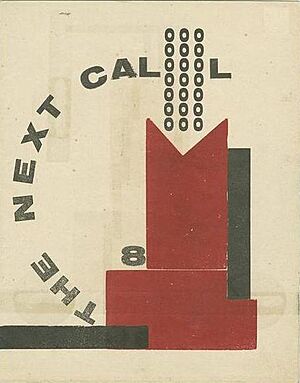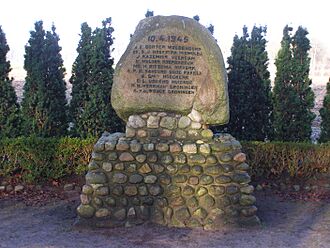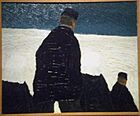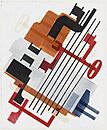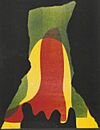Hendrik Nicolaas Werkman facts for kids
Quick facts for kids
Hendrik Nicolaas Werkman
|
|
|---|---|
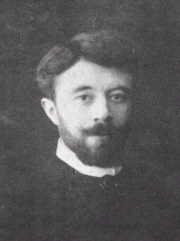
H. N. Werkman in c. 1906
|
|
| Born | 29 April 1882 Leens, Netherlands
|
| Died | 10 April 1945 (aged 62) Bakkeveen, Netherlands
|
| Known for | Typography, graphic design |
Hendrik Nicolaas Werkman (born April 29, 1882 – died April 10, 1945), often called H. N. Werkman, was a Dutch artist, designer, and printer. He was known for his experimental art and printing methods. During World War II, he secretly ran a printing press to help the Dutch resistance. Sadly, he was killed by the Gestapo (the Nazi secret police) just before the war ended.
Contents
Life and Creative Work
Werkman was born on April 29, 1882, in Leens, a town in the Groningen province of the Netherlands. His father, a vet, died when Hendrik was young. After this, his mother moved the family to the city of Groningen.
Starting a Printing Business
In 1908, Werkman opened his own printing and publishing business in Groningen. At its busiest, about twenty people worked there. However, financial problems forced him to close it in 1923. Werkman didn't give up; he started over with a small workshop in the attic of a warehouse.
Joining De Ploeg and The Next Call
Werkman was part of an artists' group called De Ploeg ("The Plough"). He printed posters, invitations, and catalogs for them. From 1923 to 1926, he created his own unique magazine called The Next Call. This magazine was very modern for its time. He experimented with different typefaces (font styles), printing blocks, and other printing materials, often making art that looked like collages.
He shared his magazine by trading it with other modern artists and designers from different countries. This way, he stayed connected with new art ideas happening across Europe. He learned a lot from artists like Theo van Doesburg, Kurt Schwitters, and El Lissitzky. Werkman himself said that even if he didn't always understand the words in the foreign magazines he received, he always found new ideas in their pages.
New Printing Methods and Tiksels
These connections were very important because Werkman couldn't travel much while building his business. In 1929, he finally got to visit Cologne and Paris. After these trips, he developed a new way of printing. He would apply ink directly to the paper using a roller, then use stamps to create special effects on a simple handpress. Some of his more complex artworks made this way needed about fifty steps and could take a whole day to finish.
Another of his experimental techniques involved making abstract designs using a typewriter. He called these tiksels. After 1929, he also began writing rhythmic sound poems, which were poems meant to be heard, focusing on the sounds of words.
Art During Wartime
In May 1940, soon after Germany invaded the Netherlands, Werkman started a secret publishing house called De Blauwe Schuit ("The Blue Barge"). This hidden press produced forty different publications, all designed and illustrated by Werkman. These included a series of Hassidic stories, which are tales from Jewish tradition.
On March 13, 1945, the Gestapo arrested Werkman. He was killed along with nine other prisoners in a forest near Bakkeveen on April 10, 1945. This was just three days before his city, Groningen, was freed from German control. Many of his paintings and prints, which the Gestapo had taken, were lost in a fire during the Battle of Groningen.
Werkman's Legacy
Werkman is buried in the Bakkeveen cemetery. There is a monument there to remember the ten people who were killed, and another monument for him in his hometown. In 1992, a Dutch director named Gerrard Verhage made a documentary about Werkman's final days, called Ik ga naar Tahiti (I’m going to Tahiti).
Just before World War II, Willem Sandberg, a museum director and trained typographer, visited Werkman. He even arranged a small art show for Werkman in Amsterdam in 1939. Right after the war, Sandberg organized a large exhibition of Werkman's work at the Stedelijk Museum and helped the museum build a big collection of his art. Sandberg also wrote a tribute to his friend, describing him as "a man with a craving for freedom... who became an artist at the moment he was economically broken, deserted by everybody, considered a freak – at that moment he created a world of his own, warm, vivid and vital.”
In 1983, Werkman’s old warehouse, where he had his workshop, was turned into new workshops and named after him. In the city museum's graphic design section, there is a workshop that shows his printing equipment. In 1999, the H.N. Werkman Foundation was created to help people learn more about his work. A large collection of his prints, drawings, paintings, and letters was given to the Groninger Museum as a permanent loan.
One of the main high schools in the city, the H.N. Werkman College, was named after him. The school keeps his memory alive through its art classes and special projects.
Gallery of Works


